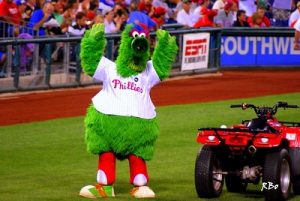When you think about copyrights… you may not imagine that Benny The Bull, Bucky the Badger, or the Phillie Phanatic are relevant… but even these sports characters are subject to copyright law. Before diving into how copyright applies to mascots, it’s important to understand some basic principles of copyright law.
What is a Copyright?
Copyright is a type of intellectual property that protects original creative works if they have minimal creativity and are fixed in a tangible medium. Although a basic shape or short phrase likely lacks adequate content, many other artistic expressions are protected. For example, the Chicago Cubs classic “C” logo or a photograph of a baseball field has enough creativity to qualify for copyright protection.
A copyright owner has exclusive rights to do things with their copyrighted work such as make copies of it, as well as create “derivative works.” A derivative work is a work based on or derived from one or more existing works. A copyright owner has the right to prevent unauthorized others from making works derived from their own work. For example, the author of a book can prevent the creation of an unauthorized movie adaptation. These rights exist regardless of if the copyright owner registers their copyright with the Copyright Office.
If a person creates an authorized derivative work, they could get copyright protection on the derivative if there is adequate new creative content added. So, the creator of a new version of a song with different arrangements could get a copyright in the new version separate from the original. Similarly, the creator of a comic book adaptation of a video game, or even a sequel to a film with new characters or storylines could potentially all have copyrights for those derivative versions separate from the original work.
A recent case shed light on how derivative work rights apply to sports mascots. In 2021, a federal trial court heard a dispute regarding the copyright validity of the treasured baseball team mascot, Phillie Phanatic, in the case Phillies v. Harrison. This lawsuit determined whether there could be valid copyright over the Phillie Phanatic, and if there could… who owned this specific copyright for the Phillie Phanatic?
The Copyright History of the Phillie Phanatic
Before discussing the lawsuit, it is important to understand the history of the the Phillie Phanatic, the mascot for the well-known Philadelphia Phillies’, a major league baseball team based in Philadelphia, Pennsylvania. In 1978, The Philadelphia Phillies, hired Wayde Harrison/Bonnie Erickson (H/E), the design team behind famous Muppets to design the original Phanatic mascot for the team. In 1979, H/E “registered” a copyright for the Phanatic’s costume design as an “artistic sculpture.” This registration enabled them to enforce their copyright against unauthorized uses such as infringement. In this registration, H/E is listed as the copyright “author.”

Five years later, H/E assigned this copyright to the Phillies to have “forever.” An assignment of a copyright means the original copyright owner grants all copyright rights to another in an agreement. Once the copyright rights were assigned to the Phillies, the Phillies could do things like make copies of the Phanatic or make derivative works based on the Phanatic without violating the copyright.
In 2018, H/E sent The Phillies a termination notice to end the assignment of the Philly Phanatic’s copyright, reverting the copyright ownership to H/E in June 2020. This notice would give H/E back the rights to the copyright for the Phanatic. Although this may seem unfair, termination of copyright licenses is possible under the Copyright Act. The Act provides that original authors (unless they created their work for a company under a so-called “work made for hire” arrangement where the company owns their works) can terminate the assignment of their copyright and regain control of their work, typically 35 years after the original transfer agreement.
In 2019, the Phillies filed a lawsuit believing that it, along with H/E, were the rightful creators of the Phillie Phanatic. Therefore, the termination was invalid. The Phillies believed that it helped design the mascot by having it wear specific Phillies apparel, like the team’s jersey and hat, and that they were incorrectly not listed as authors on the copyright registration.
In January 2020, The Phillies updated the look of the Phanatic, creating a derivative work known as “P2”, as shown in the Instagram post hyperlinked. This redesign led to further disputes consolidated into one court case between the designer H/E and The Phillies over two things: Is there a valid copyright over the Philly Phanatic and the P2 version, and if so, who owns the rights to it?
A Call from the Umpire: Can the Phillie Phanatic Design Be Copyrightable?
The Court ultimately found that there could be a valid copyright for the Phillie Phanatic. To do this, the Court analyzed The Useful Article Doctrine. This is the legal doctrine that limits copyright protection for any pictorial, graphical, or sculptural (PGS) work that is considered a “useful article.” A useful article is an object designed for a practical purpose, not just to portray the appearance of the object or to convey information. Common examples of useful articles are clothing and furniture. These are both useful articles because they have functions beyond just their designs, to wear and to sit on, respectively.
To determine whether a useful PGS work is copyrightable, the court must apply a test from the famous Supreme Court case Star Athletica L.L.C. v. Varsity Brand, Inc. The test is as follows:
- The design can be perceived as a 2d/3d work of art separate from the useful article; and
- If imagined separately from the useful article, on its own or in another medium (like on a canvas), the design of the PGS must be copyrightable with adequate minimal creativity.
Now, let’s apply this analysis to the Phanatic. The Phanatic qualified as a PGS since it is sculptural with respect to being a 3D design like other types of costumes.
The next step in this analysis of determining copyrightability is to consider whether the Phanatic is a useful article. The Court highlighted that because the Phillie Phanatic was a wearable costume it had a function beyond just conveying information or portraying art.
Following the determination that the Phanatic is a useful article, the two-step “Star Athletica Test” should be applied to determine whether the useful article is copyrightable.
1. The design can be perceived as a 2d/3d work of art separate from the useful article; and
Here, the Phanatic costume’s specific design elements can be perceived as a work separate from its useful article. This means it could be viewed as an artistic creation that stands alone as a work of visual art.
2. If imagined separately from the useful article, on its own, or in another medium (like on a canvas), the design of the PGS must be copyrightable with adequate minimal creativity.
Once it is established that the design can be conceptually separated from the useful article (i.e. wearing the costume), the next step is to assess whether the Phanatic design is copyrightable on its own. To do this, courts will often imagine the design as though it were a 2-dimensional piece of art, like a specific drawing of the Phanatic’s design elements on a canvas. In this case, the adequacy of creativity of the original Phanatic’s design was not in dispute.
Ultimately, the Court determined the Phanatic has the necessary criteria to be copyrighted due to passing the Star Athletica test, meaning the design is separable from its useful article, and it is minimally creative. Thus, H/E had a valid copyright in the Phanatic when they registered it in 1979.
The next important question is: Who owns the copyright rights to the Muppet-like Philadelphia mascot? The Phillies, who have owned the rights since it was assigned, or H/E, the original creators who have attempted to terminate the agreement? And, are the rights the same or different for the original design v. the P2?
Who Won the Copyright for the Phillie Phanatic Design?
The Court ultimately determined that H/E had valid copyright ownership of the original 1978 Phanatic design and that the termination agreement was valid. The Court did not agree with the Philadelphia Phillies’ argument that they were also original authors of the Phanatic based on the team dressing the mascot in their apparel. The Court believed that the Phillies’ additions to the mascot were not specific to the Phanatic but were copyrightable designs for the team in general.
However, the Court found that the Philadelphia Phillies had the right to keep using their updated P2 version of the mascot. Under copyright law, an assigned copyright holder will get to keep the rights to any derivative work they create before the termination is effective. This is why the Phillies have a copyright in the P2 version of the Phanatic.
Besides the Phillie’s owning the rights to the derivative, to have a copyright in it it must have copyrightability on its own. Remember that, to have a copyright over a derivative work, a design must incorporate some of the preexisting work and add new original authorship to that work. In this case, the Court determined that the P2 version of the Phillie Phanatic had enough original and creative aspects to have a valid copyright. P2 has similar attributes as the original Phanatic, maintaining its signature shape, size, and coloring. However, P2 has a bigger hat, lighter eyebrows, different eyelashes, and new red shoes in comparison to the original Phanatic. The Court ultimately believed that this derivative work was sufficiently distinctive to qualify for copyright protection. The creative changes to the mascot’s features added enough originality to make P2 separate from the original design.

Graphic Illustration from Phillies v. Harrison (S.D.N.Y 2021).

Graphic Illustration from Phillies v. Harrison (S.D.N.Y 2021).
Is this a Tie Game or is there a Winner?
The holding of Phillies v. Harrison gives H/E copyright ownership of their original design. Now H/E can license its original design of the Phanatic. This could allow H/E to increase their ability to profit from their copyright by being able to license out the original Phanatic design for things like retro-Phillies vintage merchandise. GQ recently reported that vintage clothing is “the hottest thing in fashion,” highlighting a potential new market for H/E.
However, the Court’s decision in Phillies v. Harrison allows the Phillies to keep using their derivative P2 version of the Phillie Phanatic. This means the baseball team can continue to use their beloved mascot, which has been a fixture of Philadelphia history for over 45 years. With the case settled, Philadelphia baseball fans can breathe easy: the Phillie Phanatic is here to stay.
A Home Run for Mascots and for Copyright Law
As we round the bases on this copyright case, it’s clear that the world of sports mascots is more complex than just someone putting on a costume. The ruling in Phillies v. Harrison solidifies the rights of creators like Harrison/Erickson. It allows original authors to take back ownership of creative work but also ensures that the beloved Phillie Phanatic can continue to entertain fans for years to come.

So, the next time you see a furry green creature rallying the crowd at Citizens Bank Park or on TV, remember that there’s more than just a ballgame behind that playful exterior. This case reminds us that copyright law extends far beyond what you’d typically expect, like movies, art, or books. Copyright even protects our favorite team’s mascots!

Griffin Topel
Associate Blogger
Loyola University Chicago School of Law, J.D. 2026
